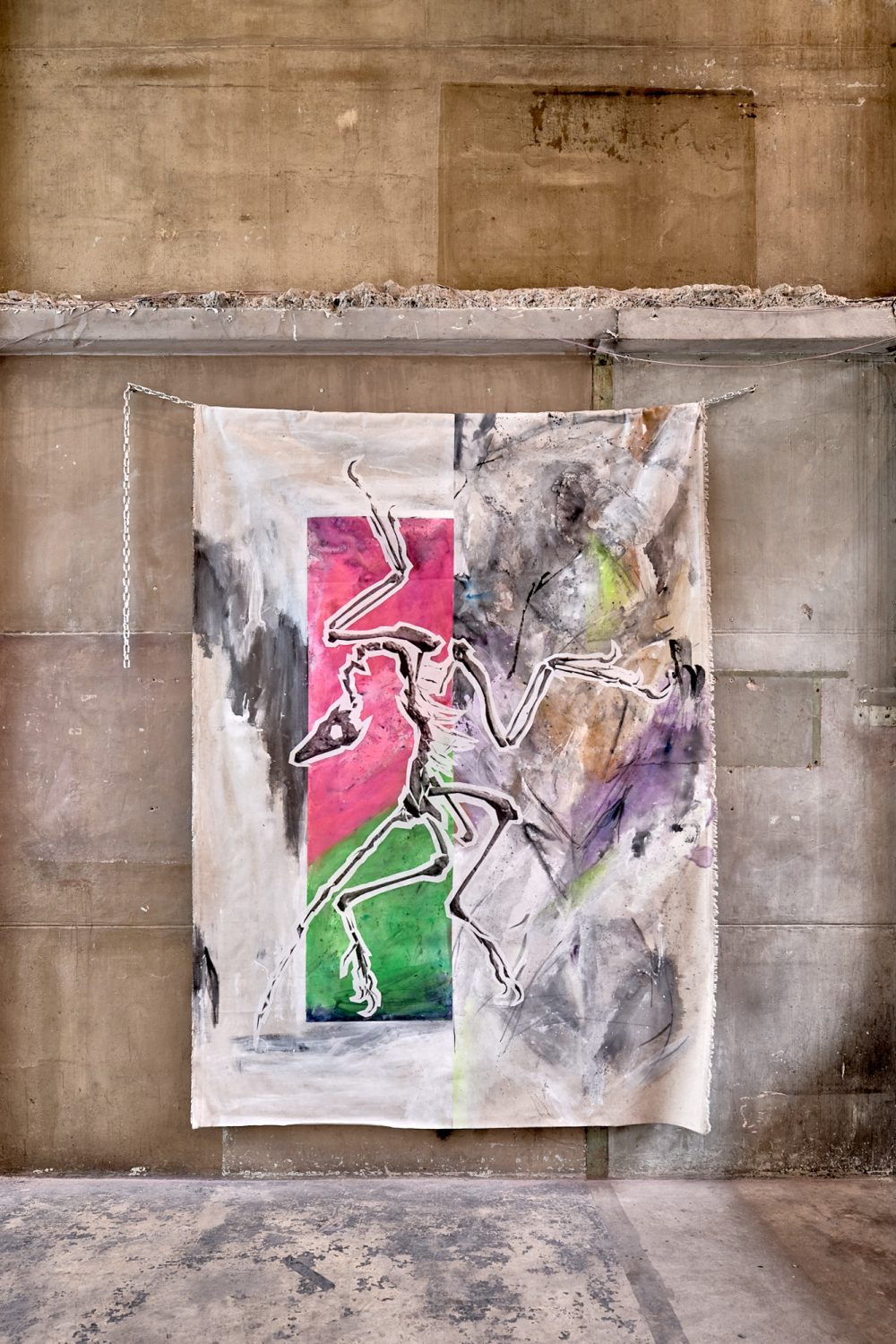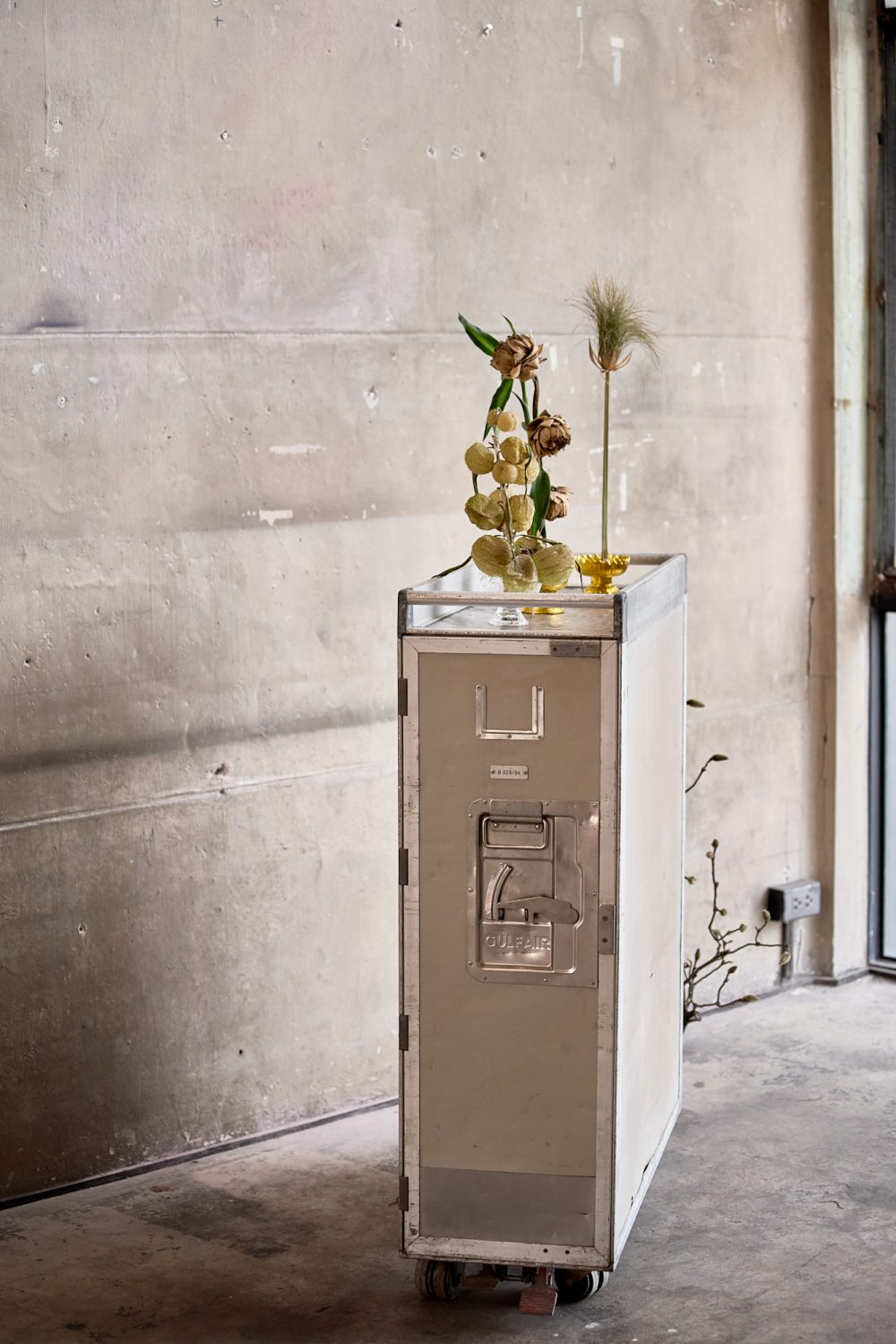EMPTY FISH TANK, A PAIR OF PANTS LAYING ACROSS THE HANDRAIL, MYSTERIOUS LETTERS WORK ON GLASS WINDOW SPREAD OUT A VAGUE FEELING OVER THE SPACE OF THE ‘STRICTE INTIMITÉ’ EXHIBITION AT SHOPHOUSE 1527. THE EXHIBITION INVITES US TO CONTEMPLATE THE ‘INTIMACY’ WE ARE USED TO, OR PERHAPS IT IS SO ROUTINE THAT WE ALREADY FORGET THAT WE ARE USED TO.
TEXT: SURAWIT BOONJOO
PHOTO COURTESY OF TRISTAN DESCHAMPS
(For Thai, press here)
‘stricte intimité’ is a group exhibition from Thai and international artists as a part of the Bangkok Biennial 2020 art festival. In the specific space of The Shophouse 1527, each work of the nine artists participated in the conversation and exchanged views of the area different from each other. Still, at the same time, they all strung through the ‘intimacy’ and ‘familiarity’ that Tristan Deschamps, the curator, has encapsulated the exhibition space and navigated the direction of our perception.

Entering through the large steel door, one will find a coffee bar looking into the very end of the building showing video of someone wearing a costume like a “barong” – a magical creature shaped like a lion in Balinese dance. Instead, the apparel is a costume made from materials seen in everyday life, such as bottles, plastic frames, or cloth, along with remixed folk and techno music. This is the work of Indonesian artist Ican Harem entitled ROH ARUS. Walking up the stairs to the second floor, one might glance at something similar to the doormat, another of Harem’s works. It is made with a method of knitting from waste material – a shirt and pants being arranged as usual that people usually do by familiarity are to take off clothes and lay them across here and there.

On the left of the second floor, awaiting a fish head with its mouth open, printed on steel. Silver Amazon by Tammarat Kittiwattanokun was so high on the wall that one had to look up confusedly, “What the heck is the fish here?”. When walking, turning around with confusion, on the opposite side are three puppet heads, each of which sits on a styrofoam box used to store fresh stuff – something that we commonly find. The head of the puppet has a mask, also known as a veil made of fiber, in a way that completely covers the head. Some of them had frequent braid openings around their mouths, with more crystals hanging down, or the other is to knit by leaving the area from one eye to the nose.
Everyone can guess which direction the title of the piece will go. Mark No.1, 2, 3 is a series of works by Judas Companion, an artist passionate about exploring herself through the human body. Turning around to continue walking, Pisitakun’s work “ghost in the wind” hung like a curtain in the front. Looking at the work, one will see a picture telling a story like a comic. Here is the story of a pink corpse raised from the dead who came to find and do some activities. It makes you feel fun and tired at the same time as the artist chooses the sequence of narratives on the works that are not in the normal order. Rather, constantly alternating from left to right, front and back, viewers need to read from left to right. From the back right and keep spinning until the end.
After walking in and out, reading the story of the pink ghost, now one will find the detailed alternating weaves of KETSET – Ican Harem’s clothing- are in full swing. On the opposite side, there is an image of a fish tank with shells, piles of rocks, and corals lying on the ground in blue light shining from behind, but inside is empty without any living things. The work is Untitled (The Colonial Coral), another work by Tammarat Kittiwatanokun.
Looking at this work together with his first work will make you understand why there are fish, why there is a picture of a fish tank, and why are the fish not in the tank? And why is the tank empty? Which creates irresistible along with questioning our familiarity. Nicolas Pelzer’s Force-Free, displayed on a TV next to the same wall, is a 3D scan of Beef Jerky that one might first think of as human muscle. Pelzer’s work aims to bring us closer to the human body in detail, deep down to the muscle level. On the opposite side is a mixed-media work hosted: sepulchral relics by German artist Berhard Holaschcke, an abstract painting with a skeleton of a tattoo like a stick. Walking straight, you will see the letters work arranged in sentences next to a large window, arranged from the top until the floor in front of you. This sentence seems to be teasing us who are looking for something.
“…IT LOOKS LIKE I’M GONNA HAVE TO SAY SOMETHING TO SOMEONE ON HERE CAUSE YOU ARE USING MY NAME…”
“…WHOEVER YOU ARE YOU WILL KNOW ME BELIEVE THAT”
‘Identity’ and ‘name’ are the themes Dennis Buck wanted to present in “Portrait of a Dennis Buck”. You’ll see three flowers nestled in tiny golden pans on top of the food trolley we often see on planes. Saskia Fischer’s Meteorology work. One more glance, a brown stick in a vase lying on the floor. Our friend Fischer is talking about religion and beliefs through her flowers. And then Claude Eigan’s final work, Supper Host, a ceramic tique sculpture with water dripping from its ass inviting audiences to consider the danger in beautiful appearance, flipping the opposite side from sucking, is the source of life for you to experience.

The ‘stricte intimité’ exhibition shows at the Shophouse 1527 from February 27 – March 26, 2022. We talk to Tristan Deschamps, the exhibition’s curator, about the stories from the start to each detail and information of the work.
art4d: Can you tell us about the starting point of the project? How did you come up with the idea? And why ‘stricte intimité’ ?
Tristan Deschamps: In 2019 I was invited by Sathit Sattarasart (former curator who initiated this exhibition) to curate an exhibition for the Bangkok Biennial 2020. I decided to then work with the concept of intimacy and the tension between the public and private spheres. The title ‘stricte intimité’ refers to the French term which emphasizes the absoluteness of intimacy and which I thought was great to work with. Then Covid happened, and everything took a different turn.

art4d: How does each work express its intimacy and/or familiarity?
TD: The selected works each represent or engage with a different aspect of intimacy. For instance, the rendered work of beef jerky and the high definition via 3D scanning of the muscle tissue in Nicolas Pelzer’s video gets close to the human body on a detailed level, whereas Saskia Fischer’s site-specific installation deals with our intimate relationship with religion and beliefs. Dennis Buck also works with identity and the name we bear and its meaning, also through a site-specific installation. Claude Eigan’s work represents tiques made out of ceramic, creating a strong contrast between something that fixes itself within our intimacy and which can be dangerous but that is made beautiful by its physical realisation.
Judas Companion’s mask installation refers to the direct way to which one can protect their intimacy, for instance, by covering one’s face. Ican Harem’s clothing works and video also engage in intimacy as the things we wear that are close to us physically, and the use we make of them. Bernhard Holaschcke’s recent painting is also a direct relationship to intimacy as it is part of a series that the artist started during the confinement, and which he created for this exhibition. Pisitakun Kuantalaeng’s work was also made for the show and directly refers to the present past through the story of a ghost. Finally, Tammarat Kittiwatanokun’s work works on the space of intimacy with reference to the zoo and the space animals are being given and how it translates into our approach to society in a post-colonial context.

art4d: What is interesting about this site-specific, The Shophouse 1527? Why did you choose this space? And how do you deal with it?
TD: The Shophouse 1527 offered intriguing and challenging exhibition space, with a lot of light dispersed through differently positioned windows, which was really fun to play with. The sober aesthetic and its location, between the new and the old Bangkok, made it the perfect location for the exhibition to take place.
art4d: We are really interested in the ceramic work of Claude Eigan – there was water dripping in some pieces. Could you tell us how it works? And more information about it? Is it a tique? If so, why is it?
TD: Those are Tiques, a little insect that fixes itself on the human body, sometimes behind the ear or under the armpits, and sucks blood. They are dangerous because they can transmit diseases, especially if you do not use a special tool to remove them. Some of them here are dripping water, not all. The water falls into a metal gutter and through contact mics and speakers, the sound is amplified, spreading throughout the space. The idea of them dripping water reflects on the fact that tiques sometimes gorge themselves on too much liquid and could burst.
art4d: Saskia Fischer’s work is also amazing. Would you elaborate on the idea of those flowers?
TD: Thank you! This is a site-specific work by Saskia Fischer, who sourced the flower material at the local flower market in Bangkok. Some of them reflect on religion, such as the lotus flower, and some on femininity. They also add a certain sense of temporality to the work since the flowers will change and evolve throughout the exhibition.
art4d: Lastly, do you have anything to say to the audience?
TD: I wish for the audience of the exhibition to feel warmly welcome, and I hope that the ideas and togetherness that I wanted to create while putting this show together come through. I also want to say that if anyone has questions, I would gladly answer them!
The works of art by nine artists in the ‘stricte intimité’ exhibition had taken us to observe and question these ‘intimacy’ we are used to, or perhaps it is so routine that we already forget that we are used to. Anyone can come to wonder, question, or even remain silent through the ‘stricte intimité’ exhibition until 26 March 2022 at The Shophouse 1527. There are also online seminars, performance art, and conversations throughout the show.











